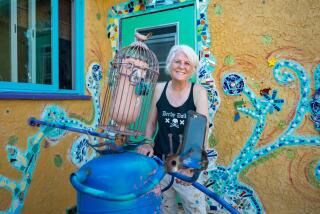Walter De Maria dies at 77; artist known for large installations
Walter De Maria, the artist whose monumental sculptures and installations combined the simplicity of minimalism with a love of scale, died Thursday in Los Angeles. He was 77.
The cause of death was a stroke suffered two months ago, according to Elizabeth Childress, the director of his New York studio. She said the artist lived in New York but was in Southern California visiting family and friends when he suffered the stroke.
De Maria’s art was often noted for its epic size, creating a sense of awe in viewers at locations as varied as the New Mexico desert and the urban wilds of downtown New York.
Throughout his career, the artist cultivated a somewhat reclusive personality as far as the press was concerned. He seldom gave interviews and disliked being photographed. He also avoided participating in museum shows when he could, preferring to create his installations outdoors or at specifically chosen locations in cities.
As a result, his work was not widely exhibited in the United States and he never became a household name. But critics and art experts championed his work, finding his large-scale installations to be conceptual and intellectually complex while at the same time accessible to the general public.
His most famous creation was “The Lightning Field,” a land-art piece created in 1977 in New Mexico consisting of 400 polished stainless steel poles arranged in a rectangular array 1 kilometer long and 1 mile wide.
“The Lightning Field” is widely regarded as a key creation in the land-art, or Earthworks, movement. The piece has become a destination site for art lovers as well as tourists who are invited to walk among the poles — but not during storms — to experience the optical effects and perspective shifts that the layout can produce at different times of day.
The installation was one of a handful of projects that De Maria created in his long collaboration with New York’s Dia Art Foundation, a nonprofit organization that commissions long-term, site-specific installations and other projects.
In October, the artist presented his installation “The 2000 Sculpture” at the Los Angeles County Museum of Art, where it occupied most of the floor space of the Resnick Pavilion. The piece consisted of 2,000 white plaster rods arranged to form a geometric tessellation, creating different reflections of light.
“I think he’s one of the greatest artists of our time,” said LACMA Director Michael Govan, who had worked with De Maria for a number of years at Dia. “I think there’s a quality to his work that is singular. It was sublime and direct.”
“The 2000 Sculpture” was used to test the light quality of Resnick Pavilion when it was preparing to open and was later displayed for the public.
Govan said De Maria shunned the media because “he wanted the work to stand for itself.”
De Maria was born Oct. 1, 1935, in Albany, Calif. He studied at UC Berkeley, where he received a master’s degree in art in 1959. He was trained as a painter but quickly gravitated toward sculpture and other media.
The artist eventually settled in New York and kept a studio in the East Village neighborhood. His first U.S. museum show came late in his career. In 2011, the Menil Collection in Houston presented “Walter De Maria: Trilogies,” featuring three series of paintings, sculpture and other works.
De Maria’s art was more widely shown abroad than in the U.S., and he had major exhibitions in Japan and Europe.
Some of his installations are still on view to the public. In addition to “The Lightning Field” in New Mexico, he created “The New York Earth Room,” at 141 Wooster St. in New York, and “The Broken Kilometer” at 393 W. Broadway, also in New York.
The latter work features 500 solid brass rods placed on the ground at increasingly wider intervals and is a companion piece to De Maria’s “Vertical Earth Kilometer” in Kassel, Germany, which consisted of a brass rod 1 kilometer long implanted in the ground.
In a review of “The 2000 Sculpture” at LACMA, Times art critic Christopher Knight described the work as “a kind of modern flying carpet in which art, not science, operates at the most profound level of liberation.”
In addition to his art career, De Maria was a sometime musician who played drums for the New York-based rock band the Primitives in the 1960s.
His survivors include his mother, Christine De Maria; and his brother, Terry.
More to Read
Start your day right
Sign up for Essential California for the L.A. Times biggest news, features and recommendations in your inbox six days a week.
You may occasionally receive promotional content from the Los Angeles Times.







